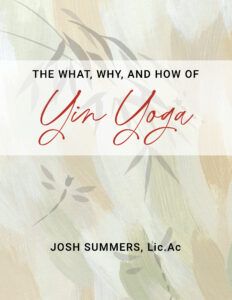Simply put, meditation is mental training, and a way to know yourself better. Meditation develops certain qualities of your mind. For thousands of years, this mental training was practiced within spiritual and religious communities, often requiring a fair amount of faith, belief, and superstition on behalf of the student. But now, there is a renaissance underway, ushering in new ways of practicing and thinking about meditation.
Yin Yoga: Bitter Practice, Sweet Result
I often get the sense that when students come to a Yin Yoga class they want to feel good throughout the class, start to finish, particularly when it’s a class that seems on the surface to be “gentle” and “quiet” and “meditative”. And yet, that is not the average newcomer’s experience. At some point during the second or third pose of the sequence, newcomers often evince a grimace of distaste and concern. And this needs to be acknowledged.
Yin Yoga: The Universal Donor of Yoga
All too frequently, someone says to me: “I love how Yin Yoga makes me feel… BUT, I couldn’t just do Yin Yoga.” Based on their expression as they say this, I can only assume they think they’ve caught me in some kind of gotcha moment, where they’re exposing a blind spot in my understanding of YinYoga. And much to their surprise, I respond, “Of course, you wouldn’t ONLY practice Yin Yoga. I would never suggest that.”
Yin Yoga: How to Come Out of a Pose
When it is time to come out of a Yin Posture, you may feel a pronounced disinclination to move quickly. Remember: the tissues in the area that you have targeted will be temporarily weakened as a result of the stresses placed upon them during the hold. As such, these targeted areas tend to feel delicate, fragile, vulnerable, and tender. So, because of these kinds of sensations, it’s a good idea to encourage students to also come out of the pose slowly. Or, as I like to cue, “Come out gingerly.”
Yin Yoga: Staying Still For Time
The third principle of Yin Yoga is to stay still for relatively longer periods of time than you would in an active style of yoga practice, such as Ashtanga or Vinyasa Yoga. The question of how long you should hold the posture often surfaces. By now, you may be anticipating my answer. How long you should stay in a posture depends on a few factors: namely, the tolerance level and strength of the tissue being stressed, and the broader intention behind that stress.
Yin Yoga: Relaxing The Muscles
The second aspect of executing a Yin Yoga posture is to relax the muscles in the area that you are targeting. Confusion tends to arise when students hear this instruction to “relax the muscles.” There is a tendency to take this as a global mandate that in Yin Yoga poses ALL muscles everywhere MUST relax, but this is going too far. In practice, you endeavor to relax the muscles primarily in the targeted area that you are influencing. It’s this action of relaxing the muscles that shifts the emphasis of the posture’s stress into the denser connective tissues in and around the muscles and the joints.
Yin Yoga: Playing The Edge
In Yin Yoga, and increasingly in other styles too, there is an emphasis placed on understanding how your body is uniquely influenced by the pose and then from that, making wiser choices about how to align yourself within the pose. How you feel and adapt to what you’re feeling are important elements of Playing Your Edge in Yin Yoga poses.
What Is Yin Yoga?
Yin Yoga is an approach to yoga that is meant to be a complementary style of practice to more active styles of postural yoga. The intentions of Yin Yoga are to stimulate, strengthen, and revive tissues of the body that are not emphasized to the same degree as in active styles of yoga, hence its complementary nature.
Everyday Sublime, The Podcast
This podcast is intended to be a reflection on and for practice. For many years, I’ve signed off my monthly newsletter with the phrase, “From my practice to yours.” What this attempts to convey is that first and foremost, I’m a practitioner – a Yin yogi, an acupuncturist, a meditator. As a practitioner, I’m committed to a process of learning, refining, unlearning, integrating, and developing. I hope that these reflections on my practice help you with yours.


